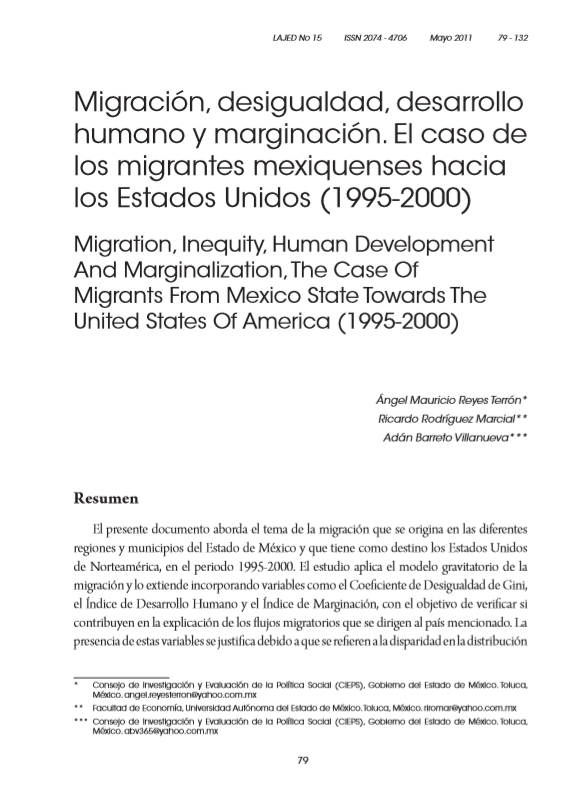Migration, Inequity, Human Development And Marginalization: The Case Of Migrants From Mexico State Towards The United States Of America (1995-2000)
DOI:
https://doi.org/10.35319/lajed.201115151Keywords:
Migration, inequity, human development, marginalizationAbstract
The document addresses the issue of the migration originated in the different regions and municipalities of the state of Mexico and which destiny is the United States of America, during the period 1995-2000. The study applies the migration gravitational model and it extends incorporating a number of variables such as: Gini´s inequality quotient the human development index and the marginalization index, both aimed to verify if such magnitudes contribute to the explanation of the influx heading to the above country. The presence of these variables is justified because they make reference to the disparity of the income distribution and the supply and availability of some public goods. The analysis takes into account the 18 regions and the 122 municipalities in which the State of Mexico is politically and administratively divided during the referred period. This study applies cross section econometrics to establish multiple correlation relations between the involved variables. As a result some quantification explaining the influx in the second half of the 90´s are offered and some recommendations about politics are distinguished.
Downloads
References
Aroca, P., G., J. D. Hewings y G. J. Paredes (2001). “Migración interregional y el mercado laboral en Chile: 1977-1982 y 1987-1992”. Cuadernos de Economía, (115) 321-345.
Baldwin, A. R. Forslid, R. Martin, G. P. Ottaviano y F. Robert-Nicoud (2003). Economic Geography and Public Policy. Princeton, N.J.: Princeton University Press.
Banco de México (2008). Base de datos en línea. Disponible en: http://www.banxico.org.mx/
Carrasco C., C. (1999). “Mercados de trabajo: los inmigrantes económicos”. Ministerio de Trabajo y Asuntos Sociales, IMSERSO, Colección Observatorio Permanente de la Inmigración, Nº 4. Madrid.
Center for International Comparisons at the University of Pennsylvania (1990). El ingreso per cápita en Estados Unidos. Base de datos en línea. Disponible en: http://pwt.econ.upenn.edu/
Consejo Estatal de Población (2000). Índice y grado de marginación por municipio, 2000. Base de datos en línea. Disponible en: http://www.edomex.gob.mx/portal/page/portal/coespo/
Consejo Nacional de Población. Encuesta sobre migración en la frontera Norte de México (EMIF), Varios años. Base de datos en línea. Disponible en: http://www.conapo.gob.mx/mig_int/3.htm
Consejo Nacional de Población (2008): Glosario. Disponible en: http://conapo.gob.mx/
Cortés, F. y R. M. Rubalcaba (1984). Técnicas estadísticas para el estudio de la desigualdad social. El Colegio de México.
Cortés, F. (2002). “Consideraciones sobre la marginalidad, marginación, pobreza y desigualdad en la distribución del ingreso”. Papeles de población, (31), 9-24.
De la Fuente, A. (1999). “La dinámica territorial de la población española: un panorama y algunos resultados provisionales”. Revista de Economía Aplicada (20), 53- 108.
Domínguez G., R. y H. Zuleta (2006). “Remesas y desarrollo económico. Un análisis empírico del caso mexicano”. Documento de trabajo Nº. 5, Facultad de Economía, Universidad del Rosario.
González B., J. G. (1998). “Migración laboral hacia Estados Unidos de los oriundos del Estado de México”. Papeles de población, (17), 107-137.
González, B., J. G. (2002). “Migración laboral internacional del Estado de México”. Universidad Autónoma del Estado de México: Coordinación General de Investigación y Estudios Avanzados, Centro de Investigación y Estudios Avanzados de la Población, Toluca, México.
González B., J. G. (2006). Migración y remesas en el sur del Estado de México. Papeles de Población, (50), 223-252.
Greenwood, M. J. (1975). “Research on Internal Migration in the United States: A Survey”. Journal of Economic Literature, 13(2), 397-433.
Greenwood, M. J. (1985). “Human Migration: Theory Models, and Empirical Studies”. Journal of Regional Science, 25(4), 521-544.
Guía Roji (2008). Atlas turístico de carreteras, México.
Hypergéo (2004). Enciclopedia electrónica. Disponible en: http://www.hypergeo.eu/article.php3?id_article=168
Instituto de Información e Investigación Geográfica Estadística y Catastral (2008). Producto Interno Bruto municipal. Disponible en: http://igecem.edomex.gob.mx/
Instituto Nacional de Estadística y Geografía (INEGI, 2000). XII Censo General de Población y Vivienda, México.
Instituto Nacional de Estadística y Geografía (INEGI, Varios años): Anuario Estadístico del Estado de México, México.
Lewis, W.A. (1954). “Desarrollo económico con oferta ilimitada de mano de obra”. El trimestre económico. (108), 629-673. México: F.C.E.
Loza T., M., Vizcarra, B. I., Lutz B., B. y Quintanar G., E. (2007). “Jefaturas de hogar. El desafío femenino ante la migración transnacional masculina en el sur del Estado de México”. Migraciones Internacionales, 4(2), 33-60.
Medina, F. (2001). “Consideraciones sobre el índice de Gini para medir la concentración del ingreso”. Comisión Económica para América Latina y el Caribe. Santiago de Chile.
Mendoza C., J. E. (2006). “Determinantes macroeconómicos regionales de la migración mexicana”. Migraciones Internacionales, 3(4), 118-145.
Oficina Nacional de Desarrollo Humano, Programa de Naciones Unidas para el Desarrollo (2000). Índice de desarrollo humano municipal, 2000-2005. México. Disponible en: http://www.undp.org.mx/
Pérez de Armiño, K. (2000). Diccionario de acción humanitaria y cooperación al desarrollo. España: Icaria Editorial y Hegoa, España. Disponible en: http:// dicc.hegoa.efaber.net/
Pfaffenbach, B. (2007). “Cumbre G-8 en Heiligendamm” Foro de política, cultura y economía. (3), 15-19. Deutschland
Reyes T., A. M. y Mur L., J. (2008). “Pautas recientes de la movilidad laboral entre las provincias españolas. Periodo 2001-2006”. Investigaciones regionales. Asociación Española de Ciencia Regional, (13) 85-113. Barcelona, España.
Santibáñez, J. (2004). “El saldo social de la emigración hacia Estados Unidos”. Conferencia magistral (mimeo).
Shields, G. M. y M. P. Shields (1989). “The Emergence of Migration Theory and A Suggested New Direction”. Journal of Economic Surveys, 3(4), 277-304.
Sjaastad, L. (1962). “The Costs and Returns of Human Migration”. Journal of Political Economy, 84(4), 701-719.
Schwartz, A. (1973). “Interpreting the Effect of Distance on Migration”. Journal of Political Economy, 81(5), 1153-1169.
Schwartz, A. (1976). “Migration, Age and Education”. Journal of Political Economy, 70(5), 80-93.
Todaro, M. J. (1969). “A Model of Labor Migration and Urban Unemployment in Less Developed Countries”. American Economic Review, 59(1), 138-148.
Tuirán G., A. (2005). La desigualdad en la distribución del ingreso monetario en México. Consejo Nacional de Población, México.
Wikipedia (2001). La enciclopedia libre, Wikipedia Foundation Inc. Disponible en: http://es.wikipedia.org/
Wooldridge, J. M. (2000). Introducción a la econometría. México: ftomson Learning.






